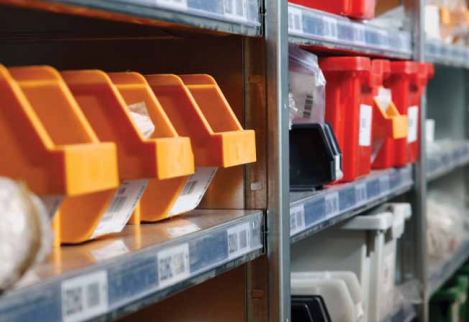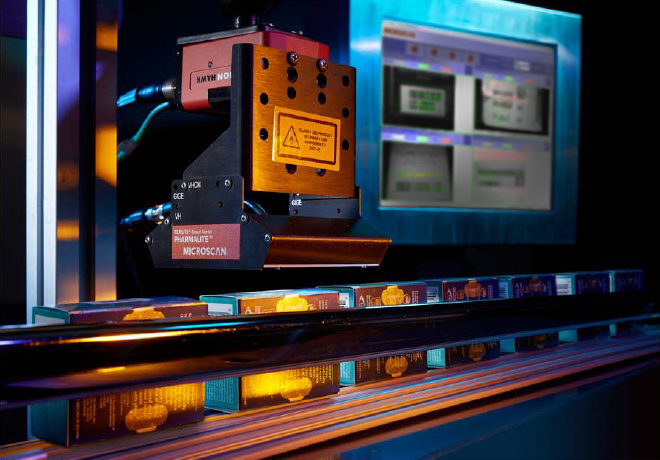4 Signs Your Warehouse Needs a Barcoding System
 Picture this…Employees are wandering the aisles of your warehouse, trying to find an inventory item to complete a shipment that must go out today. Unfortunately, the item appears to be either out of stock or has been placed in the wrong section of your facility. The problem is your manual records are incorrect so you have no way of knowing.
Picture this…Employees are wandering the aisles of your warehouse, trying to find an inventory item to complete a shipment that must go out today. Unfortunately, the item appears to be either out of stock or has been placed in the wrong section of your facility. The problem is your manual records are incorrect so you have no way of knowing.
The bottom line…Quickly locating and picking inventory is a challenge. And your current equipment and processes are not helping matters.
If this sounds all too familiar, you are not alone. In fact, a recent research study has shown that inefficient workflows cost companies nearly 3,000 productive hours and $390,000 in mispicks every year. That’s a lot of time and money down the proverbial drain.
In addition, improper warehouse management means you could be missing valuable business insights, which could help you make more informed decisions to improve the overall health of your company and avoid the above scenario.
That’s where a barcoding system comes in; it empowers you to put away the pencil and paper and forget about spreadsheets. A barcoding system is a powerful tool that reduces the piles of paperwork, decreases user error and provides critical information in real time. And it doesn’t matter whether you are a small single-store business with a warehouse in the back or a large manufacturer with several distribution centers barcoding fills in accuracy gaps that can significantly improve inventory control.
Not convinced? Your operations might be experiencing the following challenges that a barcoding system can solve:
Continue reading »
In the Era of Digital Technology, the Personal Touch Still Makes a Difference
The Power of Personalization: Consumers Increasingly Seek Customized Offers
It seems everyone today boasts a public profile on social networks from Facebook and Twitter to LinkedIn. And in the e-commerce space, consumers have become armchair critics, commenting on retailers, products and services via customer reviews. In turn, notions of privacy have been upended in the era of social sharing.
So it’s not surprising that most shoppers (74%), are willing to share some level of personal information with retailers, such as their age, likes, dislikes and purchasing history. As a bargain never goes out of style, those shoppers reluctant to share are swayed most by discount offers to provide their personal information. But they expect personalized product and sales offers in return.
One-size-fits-all retail promotions and blanket sale offers, like a diaper coupon emailed to a woman without children, seem woefully archaic today.
Shoppers prefer receiving personalized offers, for example, before leaving home via email rather than in the store so they can plan ahead. That’s because consumers often research products online, or “webroom,†before heading to the store to make a purchase. By contrast, once consumers are near a store or shopping its aisles, a relevant text offer is preferred, shoppers surveyed said.Retailers now make product recommendations based on shoppers’ purchasing patterns. That’s helped condition consumers to expect offers targeted directly at them.But while consumers increasingly expect retailers to be clued in to their needs with customized offers, they want to determine themselves how they get those offers. Once they’ve set the agenda, they’re open to a variety of marketing tactics.
Continue reading »
White Paper : iOS Compatibility
Not all barcode scanners or data capture devices are compatible with Apple iOS devices, and for those that are, a significant amount of testing and development are required to assure proper device operation. However, after a huge demand from small and medium-sized business owners to incorporate iPads, iPhones, and other Apple devices into their workforce management workflow, Apple invested extensive time and resources into certifying iOS devices with select data capture devices. Now, business owners have the ability to connect their Apple device to a data capture device via Bluetooth or a physical sled or cradle in order to conduct asset tracking, point of sale, inventory management, and other applications.
When is it coming?
iOS compatibility exists today. Many businesses ranging from small to enterprise-level are using iPads, iPhones and iPods to perform inventory management, asset tracking, and mobile point of sale activities. Hardware devices such as barcode scanners, label printers, receipt printers, cash drawers, and RFID readers are now equipped with software utilities that allow for connection to your preferred Apple device.
White Paper: Mobile Coupon Return on Investment
 Mobile coupon popularity is growing rapidly in the retail sector. One analyst firm, solely focused on mobile, predicts that mobile coupons redeemed will almost double between 2014 and 2019 to more than 31 billion.
Mobile coupon popularity is growing rapidly in the retail sector. One analyst firm, solely focused on mobile, predicts that mobile coupons redeemed will almost double between 2014 and 2019 to more than 31 billion.
Initially, the move to incorporate mobile coupons into the mix of discounts available to consumers was driven by retailers wanting to provide a unique and improved consumer experience. In addition, a handful of retailers were looking for a solution that would limit their coupon liability exposure through the use of one-time-use mobile coupons. Today, a majority of retailers are interested in the ROI of implementing a mobile coupon solution as mobile coupon use is becoming increasingly popular with consumers. This is also driving the adoption of area-imaging (2D) scanners capable of reading QR codes and other coupons directly off the screen of customers’ mobile devices.
White Paper: The Internet of Things
 What is it?
What is it?
The Internet of Things (IoT) is the coming connectivity of everything you own, everything you see. No longer will access to the internet be limited to single point interfaces like your phone or computer, or single-point data sources like web pages or servers. Nor will it be limited to you! Everything you see can, and someday will, be interconnected and sharing data: your tv, your refrigerator, your home, your car, the roads you drive on, the building you work in, the package you’re delivering…everything.
So far, the Internet of Things has been most closely associated with machine-to-machine (M2M) communication in manufacturing and power, oil and gas utilities. Products built with M2M communication capabilities are often referred to as being smart.
The Basics of Manual and Automated Picking
 1. Introduction
1. Introduction
As a small and medium size business that fulfills and ships orders for customers, the “Picking  Processâ€, if it is not already, will consume more  resources than any other area of your fulfillment operation. Whether you know it or not, you do already have a picking process, even if it is just  the daily ritual of taking the day’s orders and  walking out into the garage to find the items you  need to ship.
The question is, are you going to be comfortable  using that process as you grow and have confidence that you will achieve the most important objective which impacts your customers – accuracy?
Will the process that works for you now with  thirty orders per day still make sense when you  have one hundred thirty orders per day? What  about a thousand? If you are banking on your  own business success in the future, then the answer to that question has to be “Noâ€. Yes?
Now that you know that: 1. Picking is going to  be a huge part of your business in terms of resources and customer impact and 2. Your existing process isn’t going to cut it as you grow.  What are you going to do about it?
Continue reading to learn more about some of  your options and the benefits of being pro-active about constantly evolving tools, technology  and processes – your business depends on it!
9 Reasons Why You Can’t Afford Not to Invest in Mobile Power Solutions for Your Distribution Center
 1. Solutions for Every Scenario
1. Solutions for Every Scenario
You can’t afford not to implement solutions for your warehouse challenges. Whatever the particular challenge is at your nationwide fulfillment centers, your 1 million square foot warehouse, your 24/7 distribution center, or your manufacturing plant, mobile power solutions are available to:
- Streamline your processes
- Help your employees accomplish the most each shift
- Ensure exceptional, on-time customer service
No matter what your facility’s particular needs may be, there are viable solutions available via the implementation of customized power workstations. Whether your particular situation is similar to those Newcastle Systems customers experienced, or it’s a one-of-a-kind challenge, there is an affordable, doable, and easy solution.
The following scenarios depict companies which are ‘stuck’ or are growing, and the solutions they’ve implemented:
Continue reading »
Five Things to Know Before Choosing an Embedded Data Acquisition Device
 Successful data acquisition for barcode reading or part inspection depends on the ability of the data acquisition device, such as a barcode reader or machine vision camera, to function at peak performance within the restrictions of the application. In applications where barcode reading or machine vision inspection processes are embedded inside of equipment, limited integration space puts a unique set of restrictions on how a device can be installed, not to mention demands on the size and capabilities of the device itself. Before installation, it is important to choose a device with optimal specifications to ensure inspections can be done accurately and consistently throughout the life of the machine. This post outlines the five things an engineer should know before choosing a data acquisition device for embedding into equipment, including:
Successful data acquisition for barcode reading or part inspection depends on the ability of the data acquisition device, such as a barcode reader or machine vision camera, to function at peak performance within the restrictions of the application. In applications where barcode reading or machine vision inspection processes are embedded inside of equipment, limited integration space puts a unique set of restrictions on how a device can be installed, not to mention demands on the size and capabilities of the device itself. Before installation, it is important to choose a device with optimal specifications to ensure inspections can be done accurately and consistently throughout the life of the machine. This post outlines the five things an engineer should know before choosing a data acquisition device for embedding into equipment, including:
- Barcode Type and Orientation
- Inspection Requirements
- Application Speed
- Integration Space
- Data Communication Needs
How Mobility and Connectivity Bring Value to Financial Services
 When it comes to maintaining secure financial operations and providing top-notch customer service, success hinges on an organization’s ability to transform information into insight. Additionally, with fraud and theft on the rise, it’s critical that financial institutions constantly improve protection plans. And since no two financial organizations are alike, a variety of multi-level security options is needed. From print-on-demand (POD) technologies that enable “intelligent†access cards and radio frequency identification (RFID) to desktop printers and document and record tracking applications, organizations are capable of securing people, products and property across their operations—while maintaining a high level of customer service.
When it comes to maintaining secure financial operations and providing top-notch customer service, success hinges on an organization’s ability to transform information into insight. Additionally, with fraud and theft on the rise, it’s critical that financial institutions constantly improve protection plans. And since no two financial organizations are alike, a variety of multi-level security options is needed. From print-on-demand (POD) technologies that enable “intelligent†access cards and radio frequency identification (RFID) to desktop printers and document and record tracking applications, organizations are capable of securing people, products and property across their operations—while maintaining a high level of customer service.
Financial information, assets and communications are mission critical. It’s vital that solutions and devices enable officials to locate, track and manage personnel, confidential materials and high-value assets in real time—after all, the best security is proactive, not reactive. Furthermore, it’s crucial that only authorized individuals have access to secure locations. In addition to leveraging the value of mobile devices and printers, organizations can take advantage of opportunities afforded by the Internet of Things (IoT) by utilizing a set of enabling technologies to connect, capture and then analyze the data to make more informed decisions. Connecting devices to one cloud platform will enable them to gain actionable insight into their operations and processes—providing the asset intelligence they need to stay competitive.
Continue reading »
5 Ways the Internet of Things Adds Value to Manufacturing and Field Mobility
 Manufacturers and mobile workers are the unsung heroes of invention and innovation. Their creativity builds stronger economies in their organizations, communities and around the world, and their services keep everything moving forward. But the landscape is intricate, and it’s a constant battle to maintain profit margins, revenues and quality of service. With the vast opportunities for waste throughout global manufacturing supply chains, it’s not surprising that enterprises are focusing on cost reduction and ways to improve efficiency and accuracy across their organizations.
Manufacturers and mobile workers are the unsung heroes of invention and innovation. Their creativity builds stronger economies in their organizations, communities and around the world, and their services keep everything moving forward. But the landscape is intricate, and it’s a constant battle to maintain profit margins, revenues and quality of service. With the vast opportunities for waste throughout global manufacturing supply chains, it’s not surprising that enterprises are focusing on cost reduction and ways to improve efficiency and accuracy across their organizations.
With the increase of devices linked to manufacturing and mobility processes comes the increase in data available. However, much of this information is disjointed across the enterprise, making it difficult to obtain a realtime view of assets, people and transactions. When this decentralized scenario is replicated across the enterprise, with countless devices running disparately, inefficiencies continue to mount. This leaves enterprise workers incapable of harnessing value from their data.





